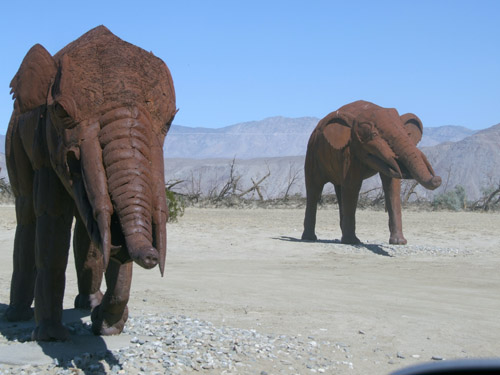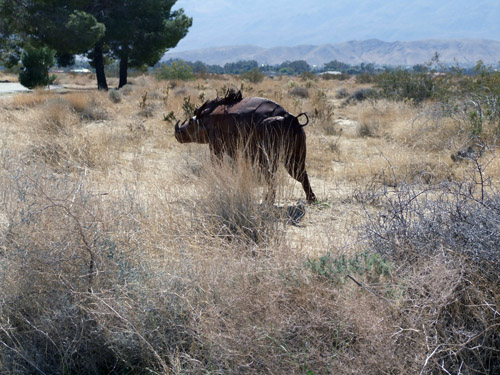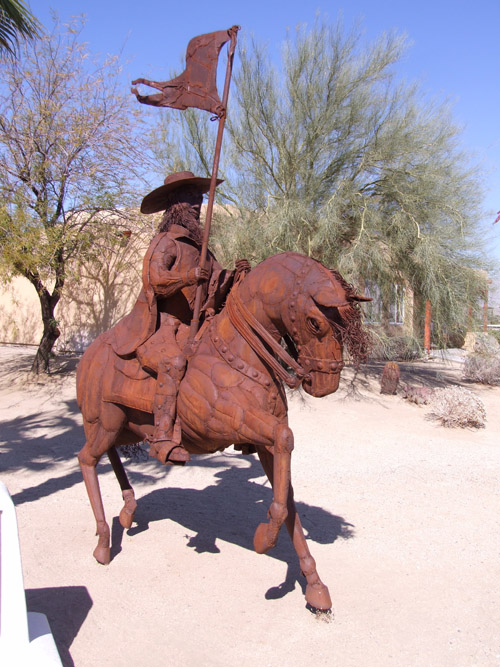
-First in a series-
By Donald H. Harrison

BORREGO SPRINGS, California –Diana Lindsay’s excellent illustrated book Ricardo Breceda: Accidental Artist prepared my wife Nancy and me to see the amazing giant sculptures of prehistoric and imaginary animals standing, feeding, nursing, or fighting in vast private stretches of land owned by Dennis Avery, heir to the Avery Label fortune. Following the “sky art” trail on which 129 figures have been carefully located in natural surroundings over the Feb. 24-26 weekend proved to be as exciting as Lindsay indicated it would be.
Co-owner with her husband Lowell Lindsay of Sunbelt Publications, which specializes in producing and distributing books about the American Southwest, the Lindsays have developed a strong sub-specialty on the Anza-Borrego Desert State Park and environs. Besides the book on Breceda, they have published eight others focusing on the Anza-Borrego region, including one by Diana on the eccentric adventurer Marshal South that was reviewed back in 2005 by our online publication. In the interest of disclosure, I should also report that Sunbelt also published my biography of Louis Rose, San Diego’s first Jewish settler.
The sculptor Ricardo Breceda grew up in Durango, Mexico, a headstrong lad and entrepreneur who didn’t like school, but loved trying all sorts of businesses. After migrating with his daughter Lianna to the United States, where he worked at construction jobs and also had a business making boots from the skins of a variety of animals, Breceda one day accepted a welding machine in trade for a pair of boots. The trade came at a fortunate time. Breceda and his daughter had seen Steven Spielberg’s movie Jurassic Park together and Lianna was absolutely enchanted by dinosaurs. Oh, please, daddy can you make me one? she asked.
Breceda decided to try, and slowly and laboriously, he assembled one from scrap metal. It was, to be frank, a learning process — the end result was not nearly the quality of the giant-sized animals that Breceda produces today.
Nevertheless, it was the all-important start.
After the dinosaur, Breceda began fashioning other sculptures, and he arranged to display them along the fence line of a property abutting Interstate 215 in the Riverside County town of Perris. More than one driver pressed down on the gas pedal to make a quick getaway when suddenly in their peripheral vision they saw dinosaurs seemingly ready to trample across the freeway. Avery was among the people who drove by the site on numerous occasions, and, according to Lindsay, the display got him thinking.
What if the creatures that lived in the Anza Borrego Desert in prehistoric times — mammoths, gompthotheres, saber tooth cats, ground sloths–could be set into the habitats they once roamed? What if they were sculpted in life-like poses, thereby creating in Borrego Springs an outdoor museum, free for anyone to enjoy?


The more Avery thought about the idea, the better he liked it, until eventually he retained Breceda and his troupe of metal workers to create the works, Lindsay reported in her book.
To areas known as Galleta Meadows, named for the hearty galleta grass that grows in the region, Breceda brought and assembled his giant metal sculptures. Sometimes they would be positioned by a bush; in other cases they would be framed by a mountain, and in others they would rise from behind mounds in the desert landscape.
After a while, Breceda’s enthusiasm for sculpting could not be contained by animals from the past. Avery also sponsored sculptures of modern-day animals, imaginary animals (like the giant sea serpent, the most recent in the collection), as well as representations of Anza-Borrego’s historic past.

Breceda pays metallic tribute not only to the borrego, or bighorn sheep, for which this area is named, but also to the region’s other namesake, Juan Bautista de Anza, the Spanish explorer who traversed this area in the 1770s while leading colonists from Sonora, Mexico, to Monterey, California.

Private car is the best way to see Breceda’s sculptures because they are spread over a vast landscape, with each grouping placed so that it can be viewed independently from the others. Marked dirt roads allow visitors to turn off the highway onto Galleta Meadows land and loop right by the sculptures. One can either get out of one’s car to photograph them from different vantage points, or simply observe them and take pictures from an open window.
Cast in metal, the sculptures are intentionally left outdoors to rust, so that they will be covered with a brown patina that makes them stand out from the landscape and be seen from far-off distances. After visiting one set of sculptures, seeing another group way off in the distance gives the feeling of being on an exciting treasure hunt. Visitors navigate their cars over dirt roads from one grouping to another. Not only is admission free, but Avery encourages people to photograph the sculptures, touch them, camp near them — in short to interact with his and Breceda’s vision.
One irony is that the sculptures are not labeled as you would expect an Avery would want to do. The only way to know that the primitive looking elephant is a gompthothere, for example, is to compare its location with a map of the sculptures issued by the Borrego Springs Chamber of Commerce and available for guests at most hotels in the area.
Breceda’s sculptures are an attraction that many would pay money to view from up close, but Avery, a philanthropist, has no need of such extra revenue. So he has converted what many people view as desert scrub land into a pathway for the appreciation of natural history and the imagination.
*
Harrison is editor of San Diego Jewish World. He may be contacted at donald.harrison@sdjewishworld.com